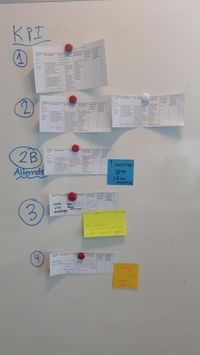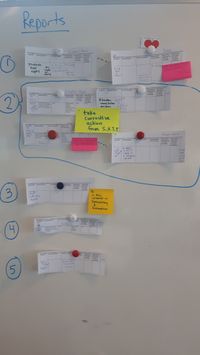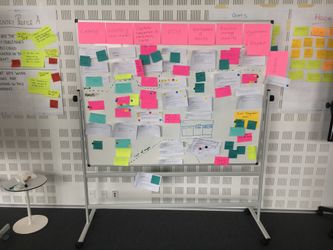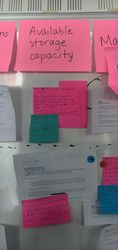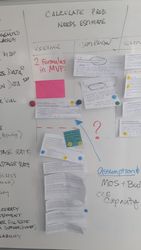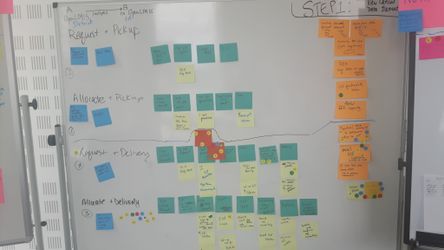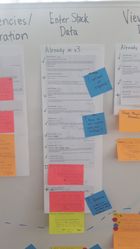Copenhagen Vaccine Module Prioritization Workshop Report
Where: Copenhagen, UN City
When: May 2-4, 2017
Table of Contents
Overview
With 27 attendees, this 3-day workshop had three objectives: (1) Create a shared understanding of the purpose of the Vaccine module; (2) Prioritize module features and the associated user stories for vaccine development; and (3) Generate enthusiasm from participants to continue engagement with the work even after workshop. The facilitators and VillageReach team generally agreed at our closing meeting that the workshop was successful in achieving these objectives; feedback evaluation forms completed by participants matched this observation, with all responses indicating "very satisfied" or "satisfied" with meeting objectives.
A significant amount of effort was put into planning this workshop, which was paid off with a strong event with very involved break-out sessions and lively dialogue. The event was noteworthy for strong engagement (with closed laptops over 3 days) and a low attrition rate from attendees. Most importantly, this event lays a strong path forward for the OpenLMIS team to propel development of the vaccine module ahead.
(photos from Josh Zamor album; photo by Alice Fu)
What's Next?
Information collected at the event is being cataloged into the OpenLMIS wiki and will be distilled into roadmap plans and software assignments after input from the OpenLMIS governing committees. The team will follow up on key open items and leverage the expertise of the group and networks to further refine the user stories. See the Key Topics and Outcomes section for more details on next steps.
In addition, a regional user-centered design workshop will be held in West Africa in June 2017. This User Design Workshop will take place the last week of June 2017 (3 days to be confirmed during the week of June 26-30) in Dakar, Senegal. This workshop will be an opportunity for VillageReach and the OpenLMIS software development team to collect feedback from country EPI staff on specific user needs and for participants to work together within the design framework to inform the optimal user experience for the OpenLMIS vaccine functionality system.
While the Copenhagen prioritization workshop focused on understanding high-level system functionality needs, the User Design Workshop will conduct activities focused on designing appropriate user interfaces (UI) for the end users of the software. Without incorporating user needs into the design of the OpenLMIS tool, the system will not be successful in improving existing EPI logistics processes. In order to address user needs and ensure relevancy for a variety of country users, VillageReach will conduct this user design workshop in Dakar, Senegal to work with country-level users to co-create the user experience for vaccine functionality. VillageReach will facilitate the workshop in French and will lead participants through various design activities over the course of the three days. The outcome of this 3-day workshop will be a set of design recommendations, mock-ups, and user personas (idealized system users) that will directly inform development of the user interface for the OpenLMIS vaccine functionality. For more information on the Senegal workshop you can check on the Senegal User Design Confluence page as planning is ongoing: Senegal User Design Workshop
In addition to the Senegal workshop, the OpenLMIS team is also looking into smaller engagements in English with specific country teams to collect similar feedback. These would also take place in summer 2017.
(photos from Josh Zamor album; photo by Josh Zamor)
Key Topics Discussed and Outcomes
The following section is for the community to think through and determine the best way to address and follow up going forward to ensure the sucess of adoption of OpenLMIS in supporting the management of the vaccine supply chain.
- Sustainability of OpenLMIS: Participants raised questions on the OpenLMIS business model and long-term sustainability of OpenLMIS. We arranged a special all-group session to discuss this on Day 3. Kaleb Brownlow (Gates) and Brian Taliesin (PATH) lead the discussion. Brian highlighted the Digital Health Initiative (DHI) program being launched by PATH. Kaleb introduced the Governance Committee and ongoing discussion around potential business models by the community and specifically at VillageReach.
- Attendees suggested many creative ideas: a revenue model where countries sell their OpenLMIS stock data to drug manufacturers; sliding-scale pricing modeled off of GAVI drug pricing where countries get free use or pay for OpenLMIS depending on their level of development; and more traditional open source dual licensing revenue models.
- Next Steps: VillageReach, led by Jake Watson, is planning a meeting at the end of May to continue the discussions around sustainability of the OpenLMIS community.
- Programmatic Data Collection: Throughout the workshop the participants raised the importance of collecting and using programmatic data alongside of logistical data to manage the program and supply chain effectively. The team expressed the importance of highlighting what data is needed at which point in the various workflows to ensure the appropriate technological solution is implemented. There were many conversations around integrating with DHIS2 and other tools to collect the data. At this point, the team is focused on gathering the needs and understanding the end user value. It is clear that whatever solution is chosen (integration or direct collection into OpenLMIS), it needs to be seamless and easy for EPI staff to enter and to obtain the data they need when they need it.
- Next Steps: The OpenLMIS team will continue to document and discover what data is needed when and the best way for it to be captured. Currently the OpenLMIS team is actively working on technical options for Program Data (e.g. https://openlmis.atlassian.net/browse/OLMIS-2323).
- Next Steps: The OpenLMIS team will continue to document and discover what data is needed when and the best way for it to be captured. Currently the OpenLMIS team is actively working on technical options for Program Data (e.g. https://openlmis.atlassian.net/browse/OLMIS-2323).
- OpenLMIS 0.9, 1.x, 2.x and VIMS Forking: The OpenLMIS team provided an overview of the history of OpenLMIS and the various forks. However, it is clear that the message can be refined and clarified as many participants had questions and weren't clear on what it meant.
- Next Step: The OpenLMIS team will refine messaging around the different versions and country implementations.
- Next Step: The OpenLMIS team will refine messaging around the different versions and country implementations.
- Guinea OpenLMIS Version: JSI raised that Guinea will be one of the next implementers of OpenLMIS. The community discussed staying closely engaged so that Version 3 can incorporate the Guinea requirements and needs as the roadmap is built out. JSI under contract with SIAPS (USAID) will initially implement the eLMIS version of OpenLMIS and eventually upgrade to version 3 with support from BMGF.
- Introducing OpenLMIS to Ministries: UNICEF staff raised the question on how how to advocate for OpenLMIS usage or how to know what country situations may be a good fit for OpenLMIS. Chris Wright (JSI) answered that it really comes down to the implementation partners and the technical assistance (TA) to help answer this. He also suggested adopting a "Certified Partners" model to help countries and others know which vendors to trust to do a proper implementation or give good advice. Another suggestion is that OpenLMIS could create a few country profiles showing different examples of how generic countries at different levels of supply chain professionalization can use OpenLMIS.
Vaccine Feature Roadmap: Based on the prioritization, VR will construct a roadmap and share with participants and OpenLMIS community. Participants voted on features they wanted to include within the MVP or identified features they thought were not needed within the MVP. There were a couple key points which will need further exploration and discussion.
- Next Step: Update participants and the Product Committee with outcomes of these discussions.
- Next Step: Update participants and the Product Committee with outcomes of these discussions.
- Regional workshop: The Senegal User Design Workshop will focus on activities around designing appropriate user interfaces (UI) for the end users of the software. This User Design workshop will take place in Dakar, Senegal the week of June 26. VillageReach will facilitiate this workshop in French and will work with country-level participants to co-create the user experience for vaccine functionality. The outcome of this 3-day workshop will be a set of design recommendations, mock-ups, and user personas (idealized system users) that will directly inform development of the user interface for the OpenLMIS vaccine functionality.
- Next Step: OpenLMIS team will invite participants and conduct the workshop in late June.
Feedback from Attendees
Evaluation forms from attendees submitted in person at the close of the workshop showed they were satisfied that objectives were achieved (n=12 of 20 non-VR attendees).
On the Net Promoter Score question, "How likely are you to recommend the OpenLMIS Vaccine Module for countries/programs you work with," the average score was 7 on a scale of 10; attendees that ranked it higher than 7 expressed that they were likely to recommend OpenLMIS Vaccine Module, while some attendees who were less likely stated that the limited scope of the discussed Minimal Viable Product (MVP) version was the key factor; a couple of attendees who gave a score less than 5 also stated that their score would likely increase after reviewing the final MVP. Graph below shows distribution of Net Promotor scores.
(photos from Josh Zamor album; photo by Josh Zamor)
Agenda
Day 1
| Topic | Notes/Presentation | |||||||||||||||
|---|---|---|---|---|---|---|---|---|---|---|---|---|---|---|---|---|
| Greetings and introductions. Review of objectives and ground rules for the workshop. | Goals :
Participants shared what they wanted to get out of the workshop. A couple are highlighted below :
| |||||||||||||||
| Introduction to the domains and the process of defining the minimal viable product (MVP). The presentation provides the overview of what workflows fall under each domain. | ||||||||||||||||
| Country Profile Activity | Participants reviewed and commented on the generalized vaccine supply chains for two countries, A and B. The objective was to come to an agreement on what the 'usual' vaccine supply chain looks like to build shared understanding and orient participants for the upcoming efforts in outlining the key workflows and user stories. link to PDFs | |||||||||||||||
| Reporting and KPIs small group break out. | ||||||||||||||||
| Attendees: Ryan McWhorter (UNICEF), Dorthe Konradsen (UNICEF), Teresa Ha (UNICEF), Kaleb Brownlow (Gates Foundation) Facilitator: Brandon Bowersox-Johnson (VillageReach) | |||||||||||||||
| Attendees: Ashraf Islam (JSI), Gemma Orta-Martinez (UNICEF), Jorgen Kofoed (UNICEF), Ian Sliney (Gavi), Josh Zamor (VillageReach) Facilitator: Chris Wright (JSI) KPIs:
Reports:
| |||||||||||||||
| Attendees: Amy Roberts (CHAI), Justin Lorenzon (Field Partners), Fesha Getahun (JSI Ethiopia), Alpha Omari (JSI Tanzania) Facilitator: Vidya Sampath (VillageReach) KPIs:
Reports:
| |||||||||||||||
| Attendees: Mitesh (NexLeaf), Michelle Arnot-Kruger (UNICEF), Matt Morio (PATH), Mike Brison (CHAI), Prakash Vaidyanathan (UNICEF) Facilitator: Rachel Powers (VillageReach) Top KPIs:
Other KPIs discussed:
Top Reports:
Other reports discussed:
| |||||||||||||||
| Recap and Feedback | Participants provided their thoughts on what worked or didn't work that day. |
Day 2
| Topic | Notes/Presentation |
|---|---|
| Review of the MVP process and objectives for the breakout sessions by domain | See the following notes on the discussions which took place. |
| Attendees: Ryan McWhorter (UNICEF), Dorthe Konradsen (UNICEF), Teresa Ha (UNICEF) Facilitator: Brandon Bowersox-Johnson (VillageReach) Key Activities discussed
|
| Attendees: Ashra Islam (JSI), Gemma Orta-Martinez (UNICEF), Jorgen Kofoed (UNICEF), Alpha Omari (JSI) Facilitator: Chris Wright (JSI) The group discussed a wide range of user stories, key activities, and scenarios. The following is a brief summary of the two day discussion. Key Take aways: Annual national forecast needs to be entered into OpenLMIS rather than building in the various forecasting logic required, especially because there are different methodologies and sometimes mixed methods for determining forecast. But some information must also be included as text to capture the methodology used, the assumptions, and any constraints that affected the final quantity forecasted (e.g. budget limits or storage capacity). Forecast should be the true "constrained forecast" on which supply plans and forecast accuracy are based. OpenLMIS should enable upload of forecast for all levels if the program follows the traditional WHO methodology.
If the annual forecast is used to determine resupply throughout each tier of the supply chain using an allocation/push system, then pipeline views (future stock position based on forecast, current SOH, AMC, and planned resupply) are MVP must haves at each level in order to predict potential stock imbalances that risk stock out or expiry due to overstock anywhere within the system. This will inform resupply decisions (timing and quantities). If lower levels requisition, MVP functionality should provide each user a suggested resupply quantity based on: Max - (closing) SOH = qty to order. This is simple and takes into account any losses/adjustments due to transfers, expiry, damage, etc. However, this will work only if the MVP Max stock level is a dynamic figure (configuration) shown as months of stock (MOS) or weeks of stock (WOS), in which:
|
| Attendees: Mitesh (NexLeaf), Michelle (UNICEF), Matt (PATH), (Josh (VillageReach) for part of the day) Facilitator: Rachel Powers (Deactivated) (VillageReach) The group focused on the key activities:
|
| Attendees: Amy Roberts (CHAI), Justin Lorenzon (Field Partners), Fesha Getahun (JSI Ethiopia), Kaleb Brownlow (Gates Foundation) Facilitator: Vidya Sampath (VillageReach) The group focused on the key activities:
|
| Team review of day's discussion and MVP scoping | Core team (VillageReach, Brian Taliesin, Chris Wright) reviewed the activities and stories within each domain. An initial line of the MVP was drawn. |
Day 3
| Topic | Notes/Presentation |
|---|---|
| Review and recap | Day 2 review and recap Participants took turns, global cafe/poster sessions style, to visit each domain's white board and quiz the facilitators on the discussions from the small group the previous day and the reasoning behind the core team's MVP line decision for that domain. |
| Prioritization | Participants voted on which user stories should be included in the Minimal Viable Product. They did this by placing their stickers on the user stories which fell below the line. If participants down-voted items that had been marked above the line, they were given an extra sticker to vote something up from below the line. Updates on the outcomes and final minimal viable product will be communicated to the community once analysis and estimations are done. The following photos demonstrate what the voting process looked like. The OpenLMIS team is currently working on digitizing the effort and conducting a more detailed estimation of level of effort in relation to the time and resources available. |
| Group discussion on sustainability, governance, and program data capture. | A majority of participants attended a break-out discussion on select 'bike rack' items: Sustainability, Governance, and Program Data capture. Kaleb Brownlow (Deactivated) started the conversation describing the governance structure and purpose of the committee. Explained how the community views OpenLMIS as a product and moving towards change and standards. There was good conversation on the long-term sustainability of OpenLMIS. Folks discussed the following topics:
Brian Taliesin introduced the Digital Health Initiative with PATH.
A lively conversation ensued around program data collection and inclusion in OpenLMIS: The following opinions and points were raised by the group:
Mary Jo Kochendorfer (Deactivated) proposed an approach of identifying all the key programmatic data points and where in the workflows the data is used by end-users and when the data is consumed/reviewed by users. We would like to identify the key data points and when the data is needed and to whom (and in what way). The key approach is to identify the scope and value to determine the best way to approach the technical implementation. Josh Zamor conducted the other concurrent session, attended by Fesha Getahun and Kalkidan Kassahun, on the OpenLMIS technical committee as well as ways in which contributors can add code to the OpenLMIS software. |
| Overview of ways participants can engage with the OpenLMIS community. | The last side highlights key discussion items which will need follow up and continued discussion. |
| Note of thanks and feedback forms |
OpenLMIS: the global initiative for powerful LMIS software




